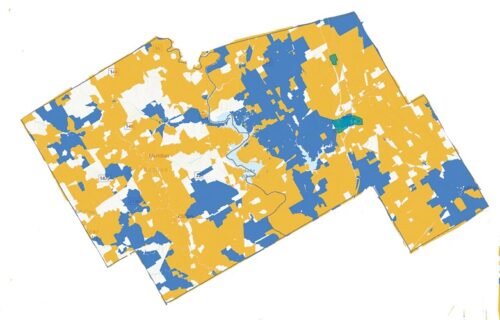State broadband map shows many areas are underserved

2.1.23 – Lakelander
Texas Comptroller Glenn Hegar has announced the release of the Texas Broadband Development Map, which uses data collected from internet service providers (ISPs) to show the availability of various types of high-speed internet access across Texas. The data will help allocate federal funding to establish high-speed internet in underserved areas.
Locally, the map shows that many areas in Hill County, and even more in Bosque County, do not have adequate broadband access.
The map lists 8,446 locations in Hill County and 1,632 in Bosque County as “served,” which the map defines as “locations where maxspeed is greater than or equal to 100 megabits per second (Mbps) for downloads and 20 Mbps for uploads.
It lists 6,447 locations in Hill County and 5,664 in Bosque County as “underserved,” meaning that maxspeed is between 25 and 100 Mbps for downloads and between three and 20 Mbps for uploads.
Just over 2% of Hill County and less than 1% of Bosque County are listed as “unserved,” which the map defines as a location where maxspeed is less than 25 Mbps for downloads and three Mbps for uploads.
Locations on the map refer to residences, buildings or, in some cases, groups of these structures.
A note on the map states that Legacy ISP, LLC is proposing a fiber-to-the-premises project to deliver broadband services to communities lacking sufficient access to broadband in Hill, Ellis and Limestone counties.
The Texas map is an interactive tool that identifies areas of the state that are eligible for funding broadband expansion projects as defined by state law. State law defines a designated area as eligible for funding if less than 80 percent of serviceable locations have access to internet at speeds of 25 Mbps downstream and three Mbps upstream.
Hegar said that the process for creating the map follows the process used by the Federal Communications Commission (FCC) to create the national broadband map and meets the statutory guidelines established in House Bill 5 passed during the 87th Legislature.
The map will be updated biannually to incorporate additional information and data gathered by the comptroller’s Texas Broadband Development Office (BDO).
“For this initial batch of data, we leaned heavily on coverage information provided by ISPs, and we followed federal guidance for speed and eligibility,” Hegar said. “However, the ISP advertised speeds submitted to us don’t necessarily match test speeds on the ground, which is a prime example of the types of flaws that are now more apparent in the federal mapping process and in the definition of broadband services.”
The comptroller said that the map will regularly be updated to reflect recent and accurate data.
“There will be multiple opportunities to challenge the accuracy of the data, and I encourage the public, stakeholders and legislators, as well as service providers and other vendors, to engage with us on the Texas map so we have the most accurate information available,” Hegar said.
“The FCC’s current definition of high-speed internet as 25/3 Mbps is becoming rapidly obsolete,” the comptroller said. “One of the things we learned talking to stakeholders around the state last year was that to be truly competitive, communities need internet that is faster than the FCC’s definition of high-speed broadband.”
The Texas Legislature created the BDO in 2021 to award grants, low-interest loans and other financial incentives to ISPs that expand access to broadband service in underserved areas.
The legislature appropriated $5 million to the comptroller to administer the program. Additionally, the American Rescue Plan Act enacted by the federal government has allocated $500.5 million to Texas for broadband expansion, while the Infrastructure Investment and Jobs Act will allocate at least $100 million.
For more information about the BDO’s work and the map, visit comptroller.texas.gov/programs/broadband.
